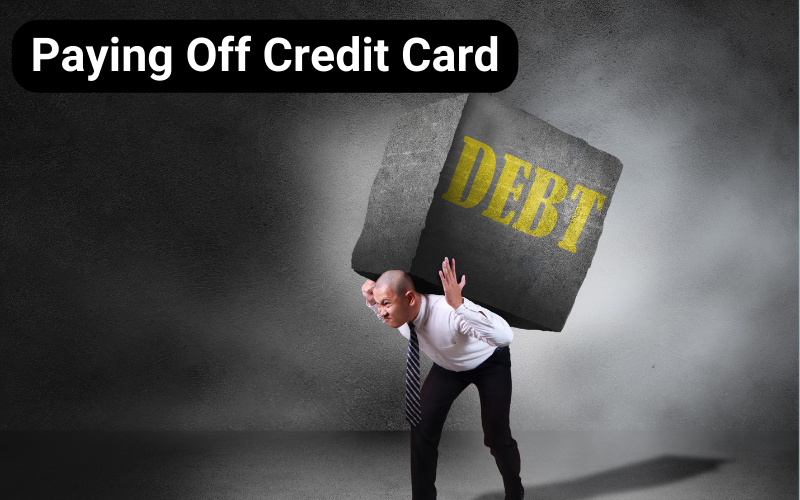Step-by-Step Guide to Paying Off Credit Card Debt Faster
1. Introduction
Credit card debt is one of the most common financial challenges people face. It can quickly spiral out of control due to high-interest rates, leading to financial stress and limiting your ability to save or invest. Paying off credit card debt quickly not only reduces the amount you pay in interest but also provides peace of mind and greater financial freedom. This guide will walk you through actionable steps to tackle your debt effectively and regain control of your finances.

2. Assess Your Debt
List All Credit Card Balances
Start by gathering information about all your credit cards. Create a list that includes:
- Outstanding balances.
- Minimum monthly payments.
- Interest rates (APR) for each card.
This overview helps you understand the scope of your debt and identify where to focus first.
Understand Your Interest Rates
Credit cards with high-interest rates cost you more over time. Rank your debts by interest rate to identify which balances are the most expensive to carry.
Calculate Your Total Debt
Add up all your credit card balances to get a clear picture of your total debt. Knowing this number will help you set realistic goals and track your progress.
3. Set Clear Goals
Determine Your Payoff Timeline
Set a target date for when you want to be debt-free. Break it down into monthly goals based on how much you can afford to pay.
Visualize Your Progress
Use tools like a debt tracker or a simple chart to monitor your progress. Seeing your balances decrease over time can be motivating and keep you focused on your goals.
4. Create a Budget
Track Income and Expenses
Document your income sources and categorize your monthly expenses into fixed (rent, utilities) and variable (entertainment, dining out).
Identify Areas to Cut Back
Review your spending habits and look for areas where you can reduce costs. For example:
- Cooking at home instead of dining out.
- Cancelling subscriptions you don’t use. Redirect these savings toward your debt payments.
Allocate Extra Funds to Debt
Dedicate any additional money—like bonuses, tax refunds, or side gig income—directly to your credit card debt.
5. Choose a Debt Repayment Strategy
Snowball Method
Focus on paying off the smallest balances first while making minimum payments on other cards. This method builds momentum as you eliminate debts one by one.
Avalanche Method
Prioritize paying off the card with the highest interest rate first. While this may take longer to see results, it saves the most money on interest.
Hybrid Approach
Combine both strategies: start with small balances to build confidence, then switch to tackling high-interest debts.
6. Negotiate with Creditors
Ask for a Lower Interest Rate
Call your credit card company and request a reduced APR. Highlight your good payment history or financial difficulties to strengthen your case.
Explore Hardship Programs
Some issuers offer temporary relief, like reduced payments or waived fees, for those facing financial challenges. Inquire about these programs to ease your burden.
7. Consider Debt Consolidation
Balance Transfer Credit Cards
Transfer high-interest balances to a card with a low or 0% introductory rate. Be mindful of balance transfer fees and ensure you can pay off the balance before the introductory period ends.
Debt Consolidation Loans
Take out a personal loan to combine multiple debts into one payment at a lower interest rate. This simplifies your finances and reduces overall interest.
Risks to Consider
Debt consolidation only works if you stop accumulating new debt. Otherwise, you risk falling deeper into financial trouble.
8. Increase Your Income
Find Side Gigs
Consider freelancing, taking a part-time job, or participating in the gig economy (e.g., ridesharing, food delivery) to earn extra money.
Sell Unused Items
Declutter your home and sell items you no longer need through platforms like eBay, Facebook Marketplace, or local sales apps.
Direct Extra Earnings Toward Debt
Use every dollar of additional income to pay down your credit card balances faster, rather than increasing discretionary spending.
9. Automate Payments
Set Up Automatic Payments
Schedule automatic payments for at least the minimum amount to avoid late fees and penalties.
Prioritize Payments Above the Minimum
Paying only the minimum extends your repayment timeline and increases the total cost of your debt. Always aim to pay more than the minimum to accelerate your progress.
10. Avoid Accumulating More Debt
Pause Credit Card Use
While paying off your debt, avoid using credit cards for non-essential purchases. Stick to cash or debit to prevent adding to your balance.
Adopt a “Pay-in-Full” Habit
Once you’ve paid off your credit card debt, make it a habit to pay off your balance in full each month. This prevents interest charges and keeps your finances in check.
11. Track Your Progress
Regularly Review Balances
Check your credit card statements each month to ensure payments are being applied correctly and to track reductions in your balances.
Celebrate Small Wins
Acknowledge milestones, like paying off a single card, to stay motivated. Small celebrations can make the process feel rewarding and sustainable.
12. Long-Term Financial Habits
Build an Emergency Fund
Save three to six months’ worth of expenses to handle unexpected costs without resorting to credit cards.
Maintain a Budget
Continue tracking income and expenses even after becoming debt-free to ensure you’re living within your means.
Use Credit Responsibly
Use credit cards sparingly and only for purchases you can pay off in full. This helps you build credit while avoiding debt.
13. Conclusion
Paying off credit card debt faster is a journey that requires discipline, a solid plan, and determination. By assessing your debt, creating a budget, and using proven repayment strategies, you can regain control of your finances. Avoid accumulating new debt and adopt long-term habits like building an emergency fund to stay debt-free. Start today and take the first step toward financial freedom—you’ll thank yourself in the future.
